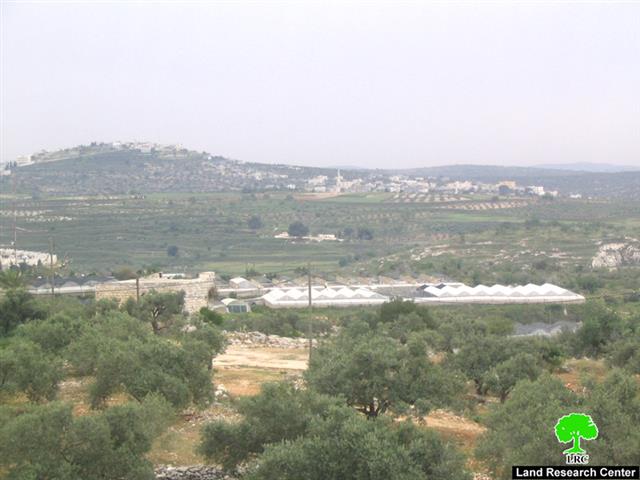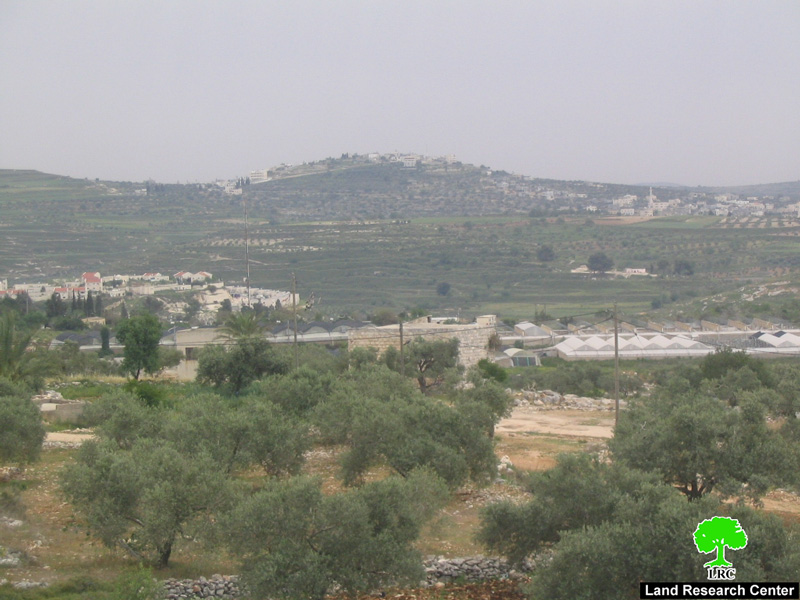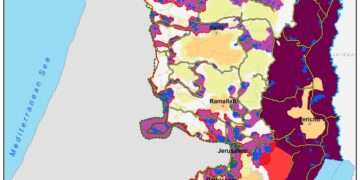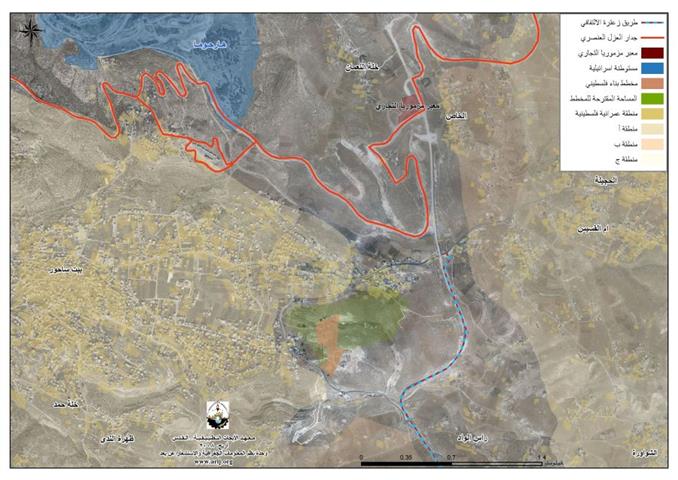On the eve of the visit of the US’s Secretary of State to the region in late March 2008, Israeli occupation authorities pledged to remove a number of colonial outposts in addition to a number of military checkpoints in the West Bank. As such, on April 3rd, 2008 Israeli occupation forces removed an outpost that was established by occupying a Palestinian house south of the village of Kufr Qaddoum in the Governorate of Qalqilia. The outpost was called Shavot A’ami as it was built on a 35-dunum land that belongs to the 60-year old Badriya Abdel Ghani Saleh A’amer. The property was taken over by Israeli colonists in 2006 due to its proximity to Road 55 in addition to its location overlooking the colony of Kadomim.
Photo 1: Green houses in the colony of Kadomim close to Shavot A’ami outpost
Upon the removal of the outpost, Palestinians from the village of Kufr Qaddoum hurried to the land in an effort to protect the house and to prevent any attempts by the colonists to reclaim it again. However, they were very surprised an hour after the local and international media has left when Israeli soldiers returned with the colonist in attempt to reinstate them into the house. The soldiers beaten up a number of the international activists, threw them out of the house and re-occupied it once again. Moreover, Israeli colonists began to install fences around the house after placing the Israeli flag atop it once again. In addition, land leveling work was embarked upon as to make additional space for more caravans to be placed in the vicinity of the occupied house in an effort to enlarge the outpost. That was despite the fact the Israeli courts have issued 3 binding decisions between 1982 and 2008 calling for the immediate removal of the colonists. They have been removed earlier, yet they have always managed to go back and re-occupy the house.
Hajja Badriya gave the following statement to Land Research Center’s field researcher: ' Our house was built in 1963 and it was used a shelter for my 9-member family. It is a one-story house with an additional 125-m2 warehouse. In the wake of the 1967 war were retreated inside of the village fearing the occupation soldiers and their harassment. However, we kept on visiting our house and working the land in its vicinity. In 1982, as we headed to our house, we were surprised to see that the colonists have transformed the house to an animal pen which led us to file a legal complaint with the Israeli legal branches. We won the case and the colonists were removed. However, the harassment continued until 2006 when we were surprised when we discovered that the colonists have taken over the house once again and destroyed most of its contents. They even added structures to it in an effort to change its appearance. They called the new outpost “Shavot A’ami”. This fact meant that they wanted to use the house as a nucleus for a new colony in the region. We contacted the organization Yesh Din as to file a complaint against the colonists. After five court hearings in Petah Tekva, the Israeli court order in its hearing session in the beginning of March 2008 the colonists to be removed from the house. The order was carried out and the colonists were removed. However, they were back after two days and overtook the house once again. They have appealed against the court’s decision and the court was rescheduled to discuss the issue until July 2008 as to give the colonists the chance to provide the court with the “evidences and proofs” they posses. When the US Secretary of State came to the region, Israeli soldiers and authorities carried out this play in front of the international media. Now, they are back in the house once again. '
Israeli Colonies Established on the Lands of the Village of Kufr Qadoom:
The village of Kufr Qadoom has an area of 20,000 dunums and is located east of the city of Qalqilia. It is a prime target of Israeli expansionist policies due to its strategic location. A Jordanian military camp used to be located in the vicinity of the village. After the Six Day War in 1967 Israeli occupation forces transformed the camp into an Israeli military point. In 1975 the military point was converted into a colony that was later named “Kadomim.” Its area is about 1090 dunums that were confiscated from the villages of Kufr Qadoom and Jitt. Its population is 3290 colonists served by a local synagogue in addition to a number of agricultural farms as well as a farm to breed and raise horses. Moreover, up until 2006, the headquarter of the Israeli DCL for the Qalqilia and Salfit was present in the colony.
It is worth noting that Israeli occupation forces have controlled in 1982 the hills overlooking the colony from the eastern directions. The forces placed on these hills the nucleus for the colony of Kadomim Eliet. Currently, this colony has an area of 533 dunums in which about 300 colonists live.
Photo 2: The colony of Kadomim Eliet
Moreover, a group of colonists took control of a piece of land in the valley of Jabal Mohammad located east of the village in the year 2000. They’ve established a nuclei for a new colony called Har Hamid which so far grew to an area of about 100 dunums forcibly taken from the lands of the village.
The Colony of Kadomim and its Effect on the Lives of Kufr Qadoom Villagers:
Since its establishment in 1974, the colony of Kadomim and its satellite colonies have been a cause of agony and threat on daily basis to the Palestinians of Kufr Qadoom. The lives of the Palestinians of the village have been negatively affected on a number of fields including:
The Environment: The colony of Kadomim and its satellite colonies is the main reason behind the spread of environmental pollution as well as a number of skin diseases in the village. That is due to dumping the sewage of the colonies into village lands especially in the northeastern direction (a.k.a. Al Khawarej area) and in the valleys of the village of Beit Lid. Additional sewage dumping is commonplace in an area known as the valleys of the village of Hijja which has led to the pollution of 300 dunums of the most fertile lands in the village and other nearby villages. It is worth noting that Israeli occupation forces prevent Palestinians from reaching the polluted region even the employees of the Palestinian Ministry of Health and the Ministry of Agriculture who were prevented on a number of occasions. .
The Demography: As Israeli occupation forces prevent the building expansion of the village (especially in the eastern direction), an acute housing crisis is expected to take place in the near future. Even electricity was not allowed to reach the village despite the fact that the electricity generator as well the High Voltage Beams are present and installed in the village through funding from the Belgium Government.
The Economy: Israeli occupation forces prevent Palestinian farmers from getting close to their lands especially those located near the colony of Kadomim and its satellite colonies. These lands are considered to be the most fertile lands in the village as 55% of the residents of the village depended on these lands as the main source of income. During the olive picking season in 2007, coordination with the Israeli DCL was carried out as it was requested through the Palestinian DCL. However, the Palestinian farmers were practically subjected to being forced out of the land under the pretext of the end of the allotted time or that the Palestinians were causing “discomfort” for the colonists. These two factors, among others, have caused a steep decline in the economic status of the residents of the village.
The Psychological Effect: The daily harassment by the Israeli soldiers and colonists (in terms of daily arrests and beatings) has spread fear and anxiety among the residents of the village.
Photo 4: The colony of Kadomim.
Photo 3: The colony of Kadomim and the outpost of Shavot A’ami
Prepared by:
The Land Research Center
LRC


















